Revamping the TN Visa To Get Workers Where the US Needs Them
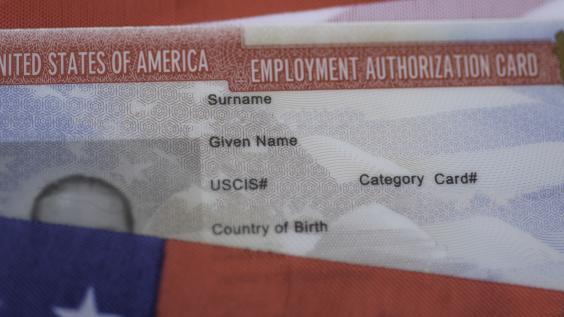
Table of Contents
Author(s)
Tony Payan
Françoise and Edward Djerejian Fellow for Mexico Studies | Director, Center for the U.S. and MexicoJosé Iván Rodríguez-Sánchez
Research ScholarShare this Publication
- Print This Publication
- Cite This Publication Copy Citation
Tony Payan and Jose Ivan Rodriguez-Sanchez, "Revamping the TN Visa to Get Workers Where the US Needs Them" (Houston: Rice University’s Baker Institute for Public Policy, June 7, 2023), https://doi.org/10.25613/fnz6-n630.
Introduction
The importance of immigrants to the U.S. economy — with or without documents — is well established.[1] In fact, in the United States, immigrants have worked in critical sectors and essential occupations for decades. For example, while only 1.6% of immigrants work in farming, fishing, and forestry, they represent around 39.2% of the total labor force in these crucial economic sectors.[2] Moreover, migrants are critical drivers of the economies of their home countries, as these workers send money back to their families, helping them to increase their standard of living and fueling consumption and growth. In recent years, remittances have represented around 4% of Mexico’s gross domestic product (GDP) — this is larger than the foreign direct investment flow into the country and on par with important export industries like fossil fuels and sectors such as international tourism.
Despite the important participation of immigrants in U.S. labor markets, especially in certain sectors, labor shortages have been a growing problem for the U.S. economy for some time. This was the case even before the pandemic, mainly due to an aging workforce and a decline in national fertility rates, but also due to a fall in immigration rates (which accelerated under the Trump administration). All of these factors have led to fewer people participating in the workforce. Consequently, with fewer individuals available to work, there are fewer people contributing to producing goods and services in the U.S., which caps economic growth. This labor force scenario does not bode well for the ongoing dynamism of the U.S. economy, demanding ever more workers. More closely linking immigration and labor markets may suggest possible solutions to both the problem of migration and the need for additional workers.
Our Suggested Solution: The TN Visa
In this paper we focus on a particular visa as a potential instrument to help U.S. labor shortages now and in the future: the TN visa.[3] Because the TN visa already exists, we argue that it is a solution hiding in plain sight that will help U.S. employers to meet their needs while charting a path for orderly and legal market integration in North America.
The next sections survey the existing temporary visas and examine current and projected U.S. labor shortages. Then we discuss the TN visa’s characteristics and explore how it can help ease these shortages by working through two main questions:
- Can the TN visa alleviate U.S. labor shortages?
- What sectors would benefit the most from modifications to the TN visa category?
We then outline how the TN visa could be expanded and improved in future renegotiations of the United States-Mexico-Canada Agreement (USMCA) to help incentivize Mexicans to participate in the U.S. labor market with authorization.[4] Since the TN visa category is a nonimmigrant one — i.e., it does not lead to permanent residence or U.S. citizenship — this may also assuage some of the nativist feelings prevailing in the United States today regarding immigration.
Existing Temporary Visas
As important sectors of the economy depend on immigrants to fill jobs, and the number of authorized immigrants is insufficient, the U.S. government has for many years granted visas to many individuals to work here temporarily, as legal nonimmigrants. The visas allow employers to hire foreign workers for specific jobs for a defined period of time, after which they must leave the country. These temporary workers must only work for the employer that petitioned for them and in the specific job they were hired for. If their visa expires or their job ends, they must leave the United States.
There is a veritable alphabet soup of visa categories for temporary work; some of the main temporary, nonimmigrant work visas include:
- H-1B — specialty occupations.
- H-2A — temporary or seasonal agricultural workers.
- H-2B — temporary non-agricultural workers.
- O-1 — persons with extraordinary ability in sciences, arts, education, business, or athletics and motion picture or TV production.
- TN — temporary professionals from Mexico and Canada (established by the USMCA).[5]
From FY 2009, the total number of temporary employment-based visas issued increased steadily through FY 2020.[6] The year 2020, however, was challenging for foreign-born workers due to the COVID-19 pandemic. The coronavirus crisis added to the effect of the Trump administration’s actions to limit immigration, such as suspending new work visas temporarily and barring foreigners from seeking employment in the United States.[7] Given these restrictions, the number of nonimmigrant visas issued at foreign service posts abroad plummeted in FY 2020 and remained low in FY 2021.
A turnaround came during FY 2022 when the visa count increased significantly, partly due to a fast-paced economic recovery that led to deep labor shortages in essential sectors such as agriculture, construction, health care, etc. and the need to fill those job vacancies as quickly as possible. Additionally, once President Joe Biden took office, his administration resumed operations to issue backlogged visas, contributing to the spike in foreign workers in the United States. All the visa categories mentioned above have now recovered after the pandemic lows (Figure 1). However, the U.S. economy still needs more workers.
Figure 1 — Nonimmigrant Visas Issued, FY 2000-FY 2022
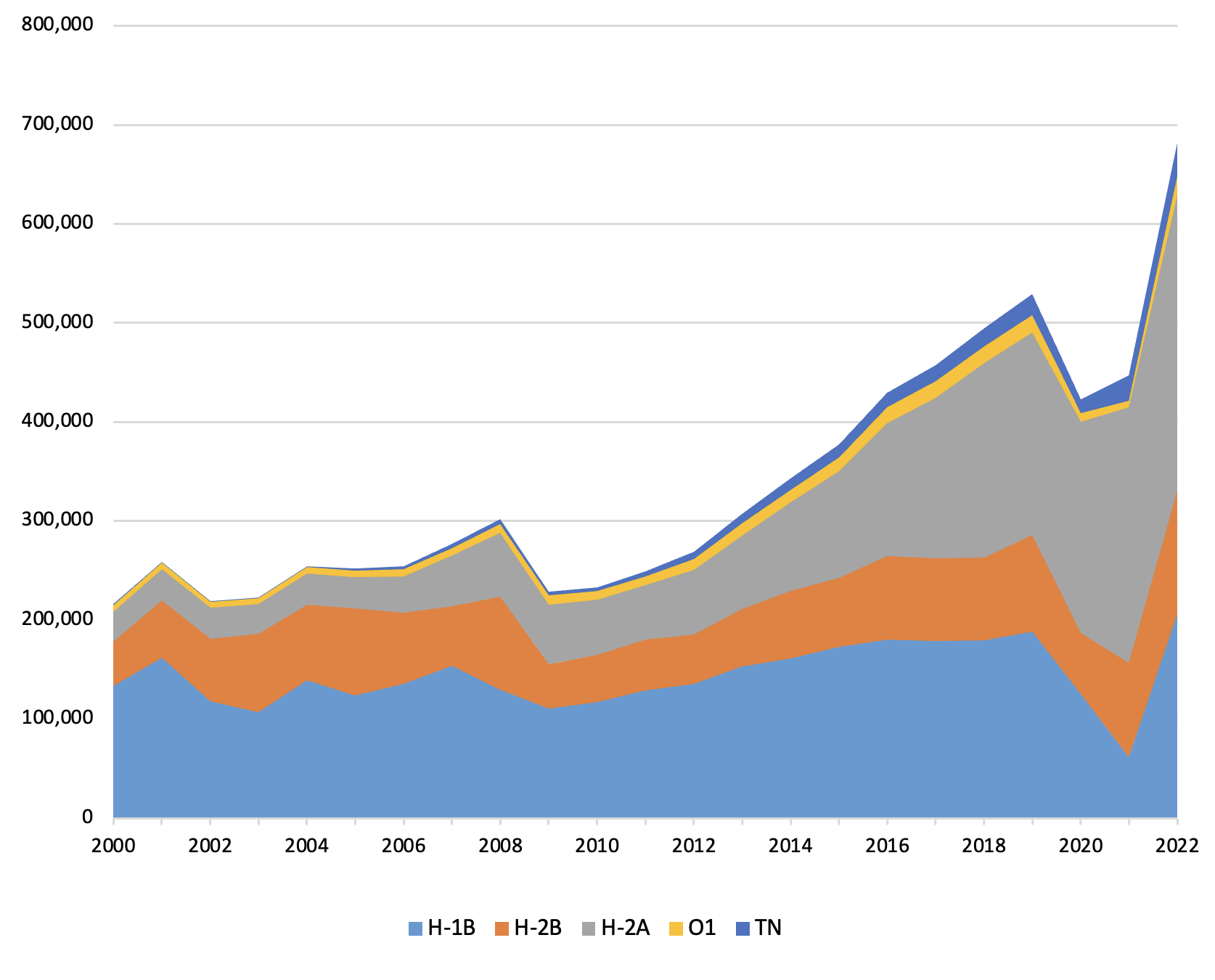
Immigration has always played an important role in providing workers for the U.S. labor market across all sectors. With reduced migration and fewer domestic workers available, temporary nonimmigrant visas have become even more important. Figure 1 shows that the TN and H-2A (agricultural sector) visas have had the greatest growth in visas issued since 2000. The TN visa covers several essential sectors and will be discussed in depth below.
Current and Projected U.S. Labor Shortages
Labor shortages occur when employers struggle to fill job vacancies due to a lack of workers in the labor market. The inability to fill vacancies has a knock-on effect. Within many industries, not having enough workers delays product delivery. For example, in construction it means a slowdown in building homes and commercial properties. Thus, labor shortages also generate supply chain disruptions, increasing competition for the limited goods available and fueling even more inflationary pressures. More broadly speaking, another economic impact of labor shortages is that employers are pressured to increase wages to attract or retain workers, and this creates inflationary pressures in the overall economy.
Labor shortages have major implications for the economy overall, negatively affecting production and delivery chains. In the long run, these shortages can hamper growth in major industries and slow GDP growth.
When and Why Did These Shortages Begin?
As mentioned, U.S. labor shortages began before the COVID-19 pandemic, as the demographic transition accelerated in the United States and the Trump administration slowed visa issuances. But the pandemic did exacerbate the problem, particularly in sectors that rely heavily on immigrant and nonimmigrant workers such as agriculture, food services, health care, transportation, and construction. The pandemic further emphasized the importance of these workers to the U.S. economy, because these industries had to continue to function while many others pivoted to working from home.
To reiterate, the main factors contributing to this labor shortage are the aging of the U.S. workforce, the low national fertility rates, early retirements, boosted unemployment benefits, and decreased immigration rates. A slowdown in the number of work visas issued to nonimmigrant workers has also played a role. All these factors (apart from the work visa numbers) have affected the labor force participation rate: It has been falling in the United States since 2009, with a slight recovery 2019-2020, until the pandemic struck (Figure 2). The most recent data for February 2023 (62.5%) shows that this rate is still lower than before the COVID-19 pandemic in February 2020 (63.4%). This translates to around 2.4 million missing workers.[8]
Figure 2 — Civilian Labor Force Participation Rate, 2000-2023 (monthly)
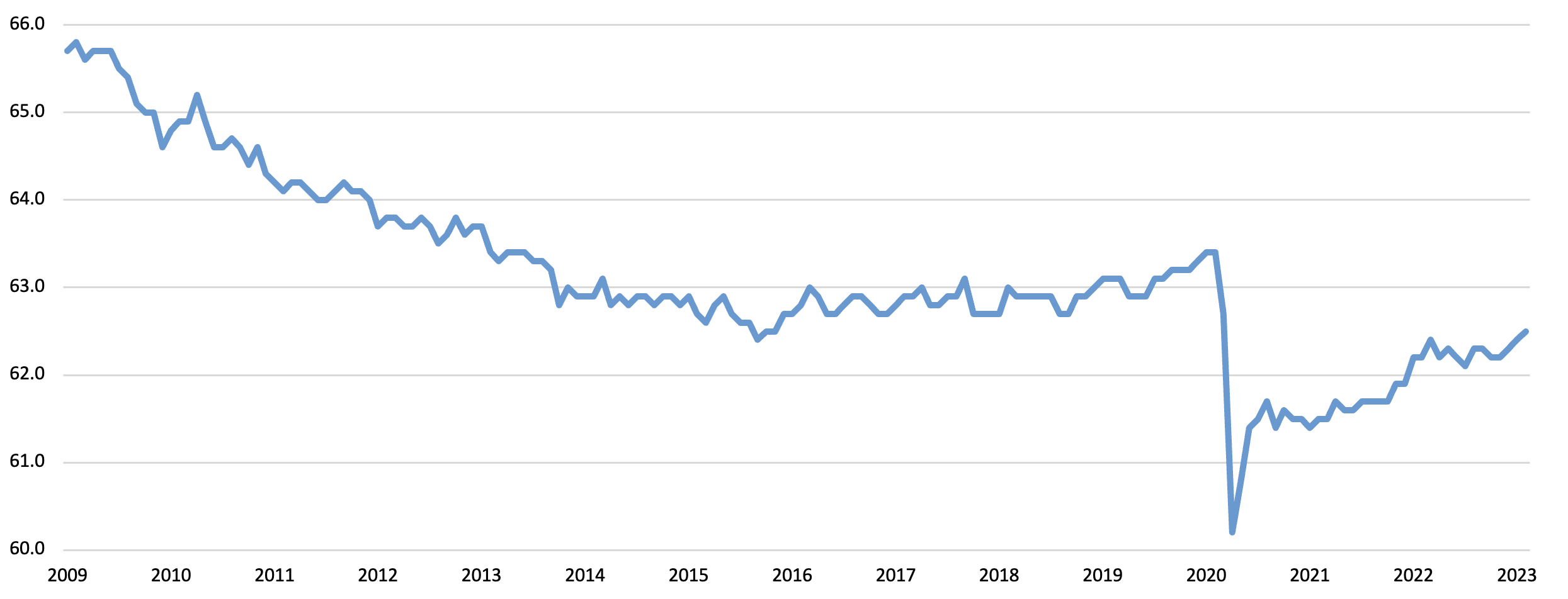
Source Based on data from the Bureau of Labor Statistics (BLS).
More Jobs Than Workers From 2018
Beginning in 2018, the last year of the Obama administration, the U.S. economy began to have more job openings than unemployed or available workers. By December 2022, there were 11.2 million job openings but only 5.7 million unemployed or available workers. At that point, even if every unemployed or available worker were matched with a job — if their qualifications allowed this — there would still be 5.5 million jobs left unfilled (Figure 3). The average for 2022 was 5.2 million jobs left unfilled, and this trend looks set to continue through 2023 and beyond. This will negatively affect U.S. economic growth and, with that, the well-being of all Americans. In fact, there are important warnings that labor shortages may become structural, restricting the ability of the U.S. economy to grow faster in the future.
Figure 3 — Job Openings and Number of Unemployed Workers (in thousands), 2015-2022
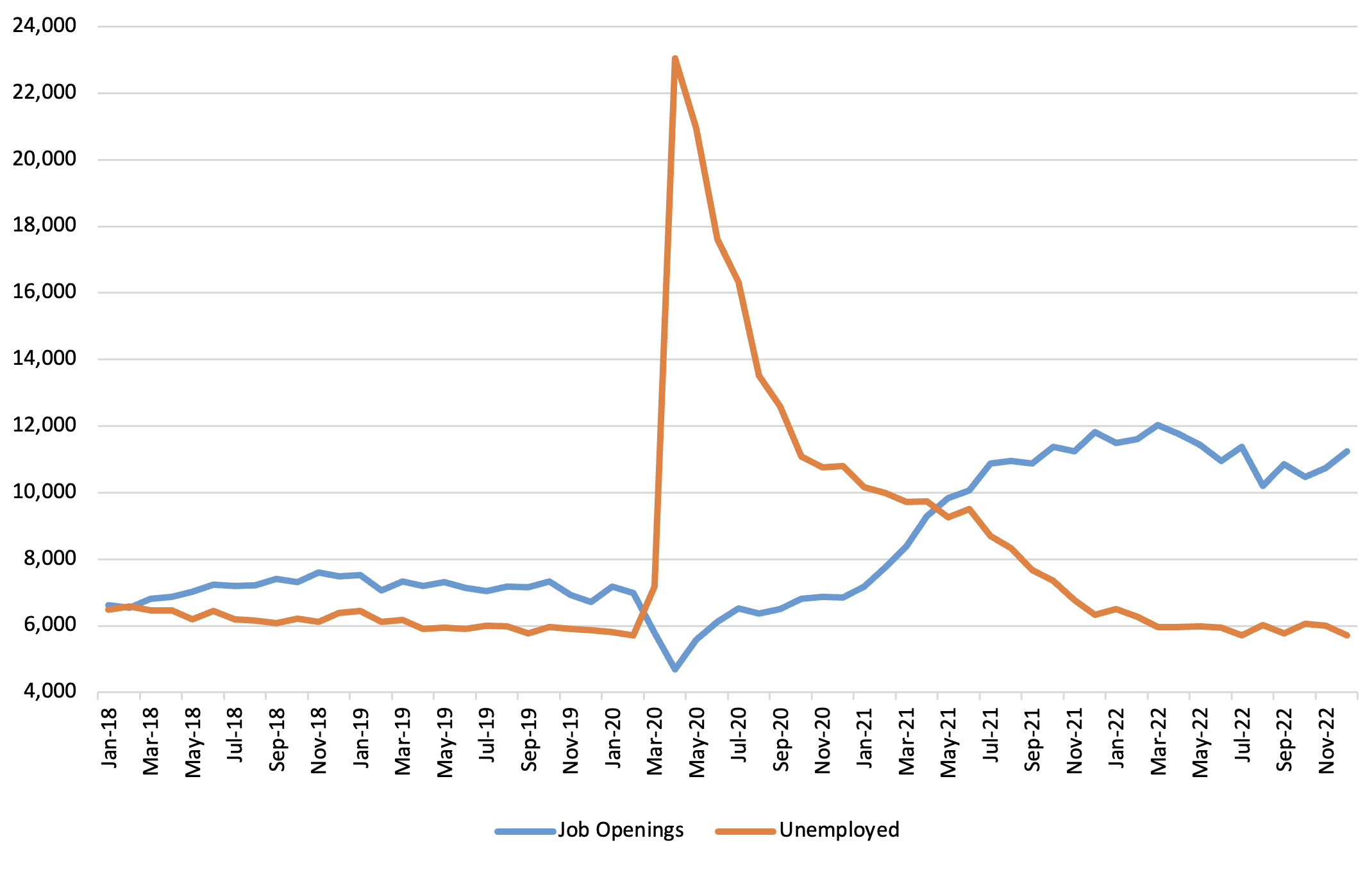
Source Based on data from the BLS.
Statistics Show the Importance of Immigrants to the U.S. Labor Market. Although these trends began before 2020, the fact that they are continuing indicates that the U.S. labor market is still struggling to recover from the effects of the COVID-19 pandemic. We observe that while the decline in immigration in recent years has also negatively affected this labor market, it has drawn less attention. However, it is clear that an increase in immigration to the U.S. could help address this labor deficit quickly and efficiently. Statistics support this view.
- Immigrants and their children contributed more than one-half of the workforce growth in the past two decades.[9]
- Immigrant workers have considerably advanced the U.S. economy, adding at least around $2.8 trillion to the U.S. GDP in 2022.[10]
- It is estimated that the shortfall of about 2 million immigrants in the United States between 2020 and 2021 had a negative impact on its GDP of around 1.1% per year.[11]
Figure 4 — Net International Migration to the U.S. (in thousands), 2010-2022
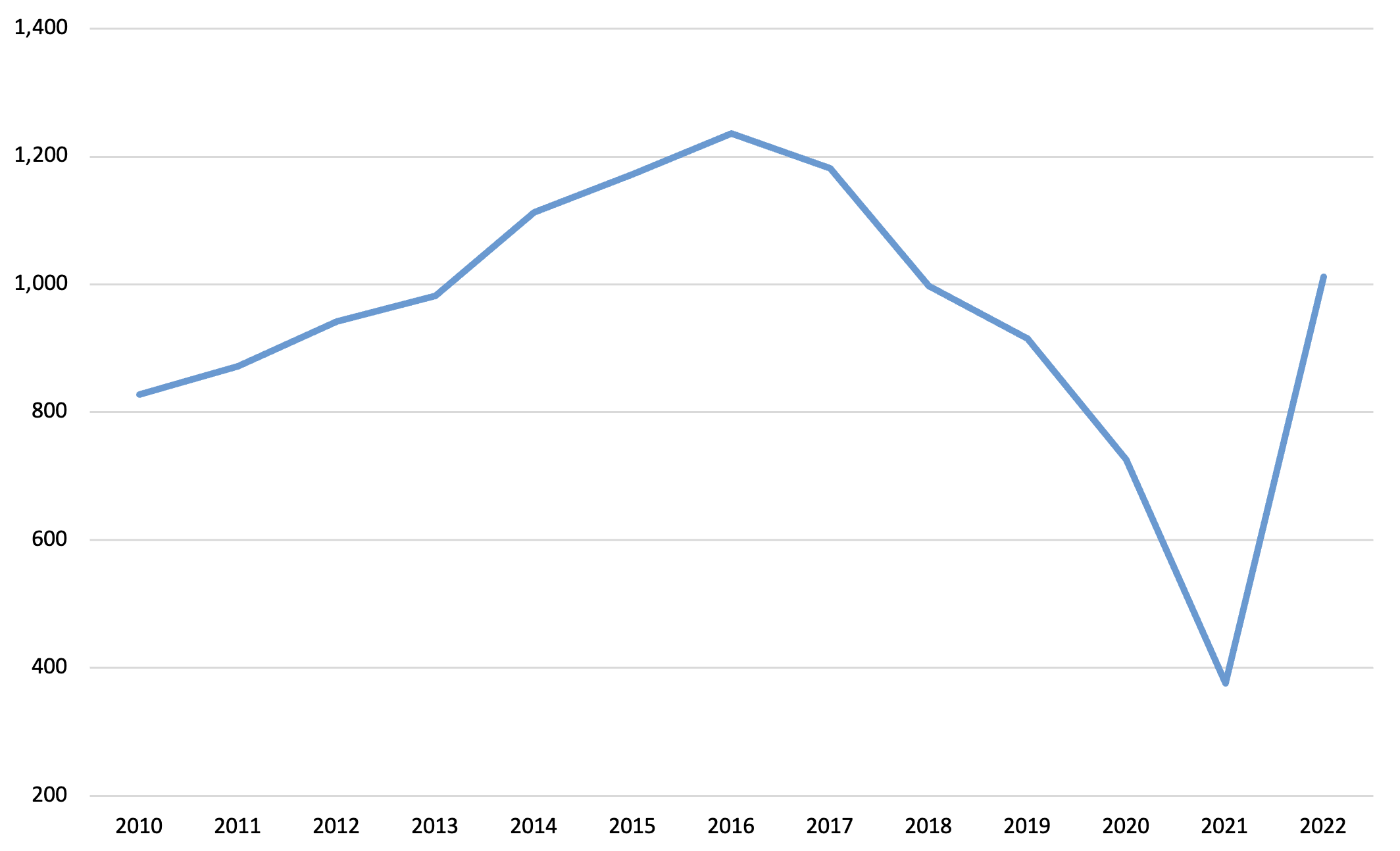
There is Room for Additional Migration. Given recent trends, there is capacity for additional migration. Net international migration — the number of immigrants minus the number of emigrants — had slowed even before the coronavirus pandemic, mainly due to reduced immigration to the U.S. (Figure 4). In 2016, it peaked at around 1.2 million people, then declined, barely reaching 376,000 in 2021. This is the slowest migration growth in decades. The reduction in immigrants seems to be one of the key elements in the increase in U.S. labor shortages since 2018.
Net international migration has since turned around, and in 2022 — for the first time since 2016 — it increased again. The 2022 rebound was expected, given that the pandemic was a major reason for the slowdown in visa issuances. This has helped the U.S. labor market, but more is needed, particularly with the continuation of lower fertility rates in the country.
The H-2A (temporary seasonal agricultural worker) visa category was the only type of visa that continued to grow during the pandemic. That growth continues today. Additionally, a temporary increase in the cap on the H-2B (temporary non-agricultural worker) visa category in late 2022 has eased some of the labor shortages. However, because these are nonimmigrant visas issued only for a limited time, they are not a permanent solution.
As the pandemic wound down, another factor that helped the rebound was the increase in immigrant visas, as COVID-19 restrictions had prevented many immigrants from entering the U.S.
But none of this is enough. Going forward, the visa paths available for immigrant and nonimmigrant visa categories will be insufficient to satisfy U.S. labor needs. The immigration laws are inflexible and visa restrictions are many. Changes to the existing legislation to allow more immigrant visas are unlikely in the current political environment. Given this, it may be a good idea to turn to temporary work visas. We argue that the TN visa is an ideal visa category to throw a lifeline to key sectors of the U.S. economy.
The TN Visa: Context and Possibilities
The North American Free Trade Agreement (NAFTA), enacted in 1994, created a unique free trade region for the United States, Canada, and Mexico.[12] The TN visa was introduced in Chapter 16 of the accord. This visa permits qualified Canadian and Mexican citizens to pursue temporary business and professional-level activities in the U.S. In 2020, the USMCA entered into force, replacing NAFTA. Despite fears of its demise during the transition, the TN visa category survived and was grandfathered into the USMCA.
The TN visa focuses on higher-skilled professions and is restricted to a list of 63 occupational categories (Table 1 below).[13] This list has remained unchanged since its inception in 1994, so it should be analyzed to see if it needs to be updated and expanded or even become a new list based on the professions that do not qualify for this visa.
TN Visa Procedure More Onerous for Mexicans
Compared to other work visas, the TN visa has the advantage of being straightforward, requiring relatively little paperwork from worker and employer. Numbers are not capped for the TN visa, and it can be renewed indefinitely if a position is open for the beneficiary. It remains a nonimmigrant visa and does not allow the beneficiary to apply for a green card. The spouses and minor children of TN visa holders generally receive TD visas, which allow them to study in the U.S. but not work.
There is, however, a disparity between the requirements for Canadians and for Mexicans, making the process more onerous for the latter.
- All Canadian citizens have to do is present the required documentation (primarily a job offer) at a U.S. port of entry or U.S. pre-clearance and pre-flight stations.[14]
- Mexicans must first obtain a visa to enter and work in the U.S. by applying directly at a U.S. consulate with the required documentation. Until 2022, TN visas for Mexicans were issued for only one year with a maximum period of stay of up to three years in the U.S.[15] In 2022, the U.S. Department of State updated the TN visa reciprocity schedule for Mexicans, providing two visa validity period options: a four-year visa and a one-year visa.[16]
Summary of Advantages of the TN Visa
In summary, the TN visa has some important advantages compared to other visas.
- It is not capped.
- It is easy to obtain.
- It is less costly than other visas.
- It can be renewed indefinitely.
- It is indexed to the U.S. economy.
- It has low rates of denial.
Elaborating on this last point, the number of denials for TN visas has decreased since 2010 and has remained around 10% since 2019 (Figure 5). This means that an applicant and their employer have a 90% probability of obtaining this visa.
Figure 5 — Refused TN Visas
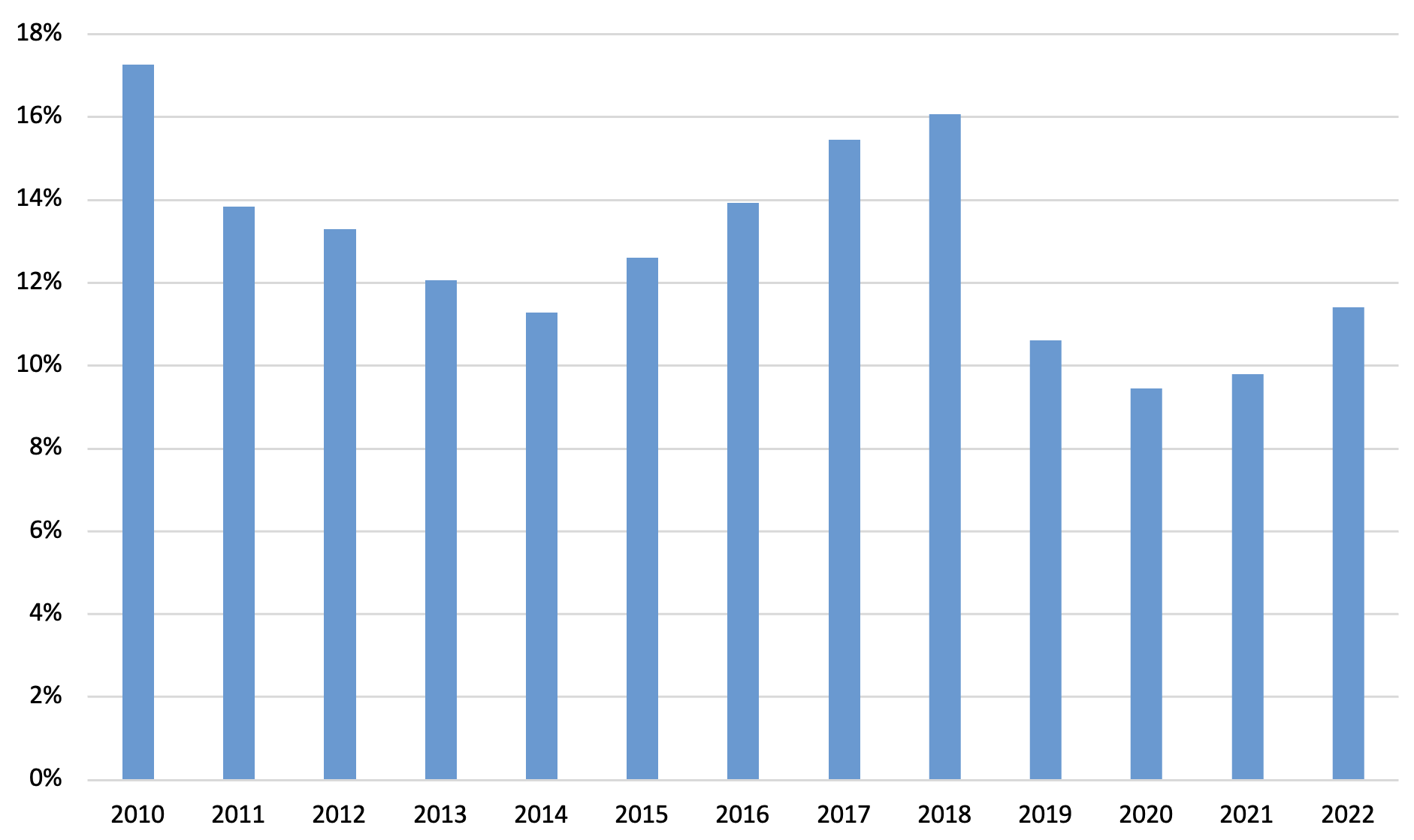
Growth of the TN Visa Category in Recent Years
The use of TN visas has skyrocketed since 2010 (Figure 6). Readers will recall that TN visa category only applies to Mexican and Canadian citizens. Mexicans who qualify and U.S. employers who find these workers valuable have realized the convenience of this visa and have applied for it in ever larger numbers. While many Canadians also use this visa, since they do not need a visa stamp, there are no official numbers of TN visa issuances for them.
From 2010 to 2022, the number of TN visas issued to Mexicans grew an astonishing 884% — from 3,392 in 2010 to 33,361 in 2022. TN visas have also increased relative to the total number of work visas issued: From around 0.7% in 2010, the percentage increased to approximately 4.4% in 2021.
Figure 6 — Nonimmigrant Visas Issued, FY 2010-FY 2022 (Index, 2010 = 100)
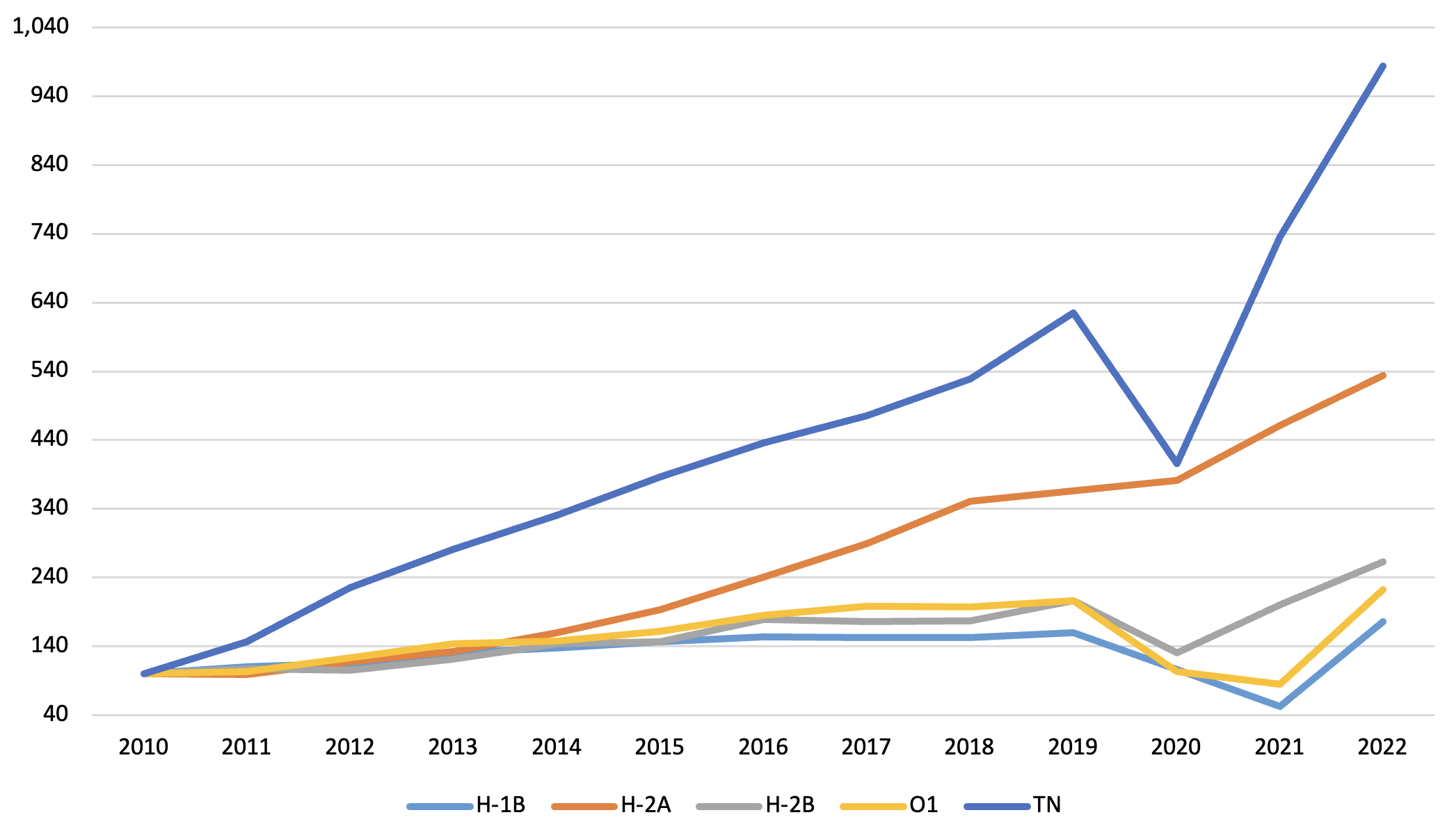
General Growth in U.S. Work Visas for Mexicans. Compared to other countries, U.S. work visas for Mexican citizens have increased considerably in recent years. This is not surprising as over time, Mexicans have occupied a privileged position in U.S. labor markets and the immigration system overall. The following statistics compare 2010 figures to those from 2021 and illustrate the recent growth.
- In 2010, the percentage of work visas issued to Mexicans was around 23%, but by 2021, this number had increased to 63%.[17]
- The visa with the highest increase in relation to the total number of work visas issued to Mexicans was the H-2A visa — it went from 49.9% in 2010 to 67.8% in 2021.
- In 2021, Mexicans represented about 93% of all H-2A visas issued to citizens of all countries that can use this type of visa.
- During the same period, the TN visa considerably increased the number of visas obtained by Mexican professionals to work in the U.S. In 2010, the percentage of TN visas was approximately 3.2% as against the total work visas for Mexicans, and in 2021 the figure grew to around 7.1%, despite the effect of the COVID-19 pandemic starting in 2020.
One note contrary to the general growth is the H-2B visa: Mexican individuals received 31.9% of the H-2B visas in 2010, and the percentage decreased to 20.2% in 2021 when Mexicans accounted for around 75% of all H-2B visas issued.
The I-94 Arrival/Departure Form. The USCIS I-94 arrival/departure form, which accompanies a visa upon entry, serves as proof of lawful admission of the holder under a TN status and indicates the duration of that status. This means the I-94 form is a great source of statistical information on the TN visa, and the figures show that the number of visas issued and admissions grew exponentially after the financial crisis ended in 2009 (Figure 7). The number of I-94 admissions with TN status peaked at 899,455 in 2011 and declined, mainly due to the COVID-19 pandemic, to 385,869 in 2021. However, this level remains high compared to other temporary work visas, and we predict that the FY 2022 figures will be higher than before the pandemic. Because of its usefulness and the need for workers in the United States, we expect this visa category to experience a quick recovery.
Notably, most admissions of people with TN visas are Canadians. In 2010, the admissions of Canadians with TN status were around 90% of the total, and Mexicans the remaining 10%.[18] By 2021, these percentages had changed, with Canadians making up approximately 70% and Mexicans 30%.[19] While Mexicans remain a small portion of all TN workers, their share is growing.
Figure 7 — TN Visas Issued and Admissions, FY 2000 to FY 2021
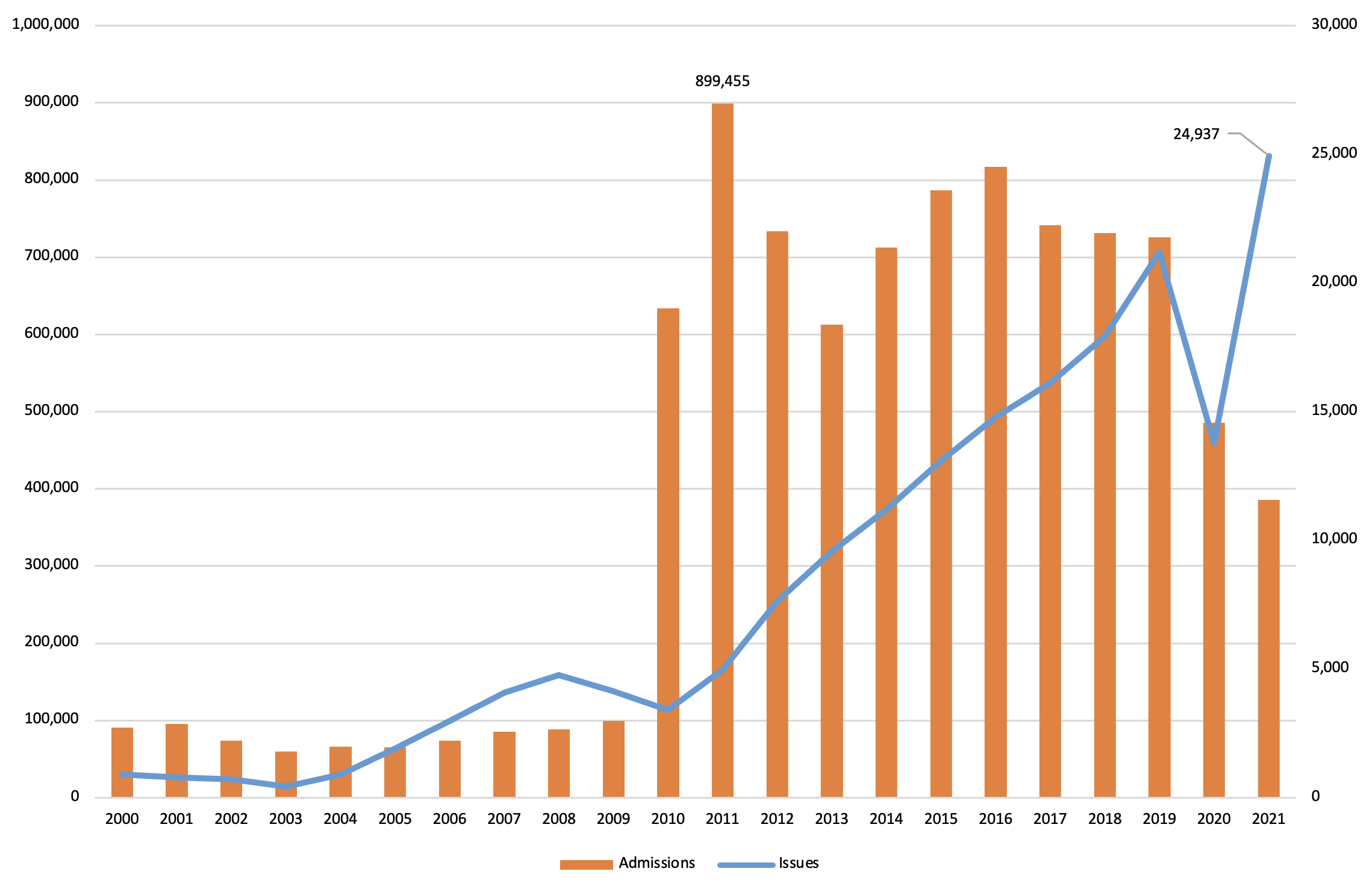
How Could the TN Visa Alleviate U.S. Labor Shortages?
Citizens of Canada and Mexico who want to use a TN visa to engage in business activities at a professional level in the U.S. must meet the established requirements, and their profession must be in the following list (see Table 1).
Table 1 — Business and Professional Activities that Qualify for a TN Visa under the USMCA and Employment Projection Change (% in parenthesis), 2021-2031
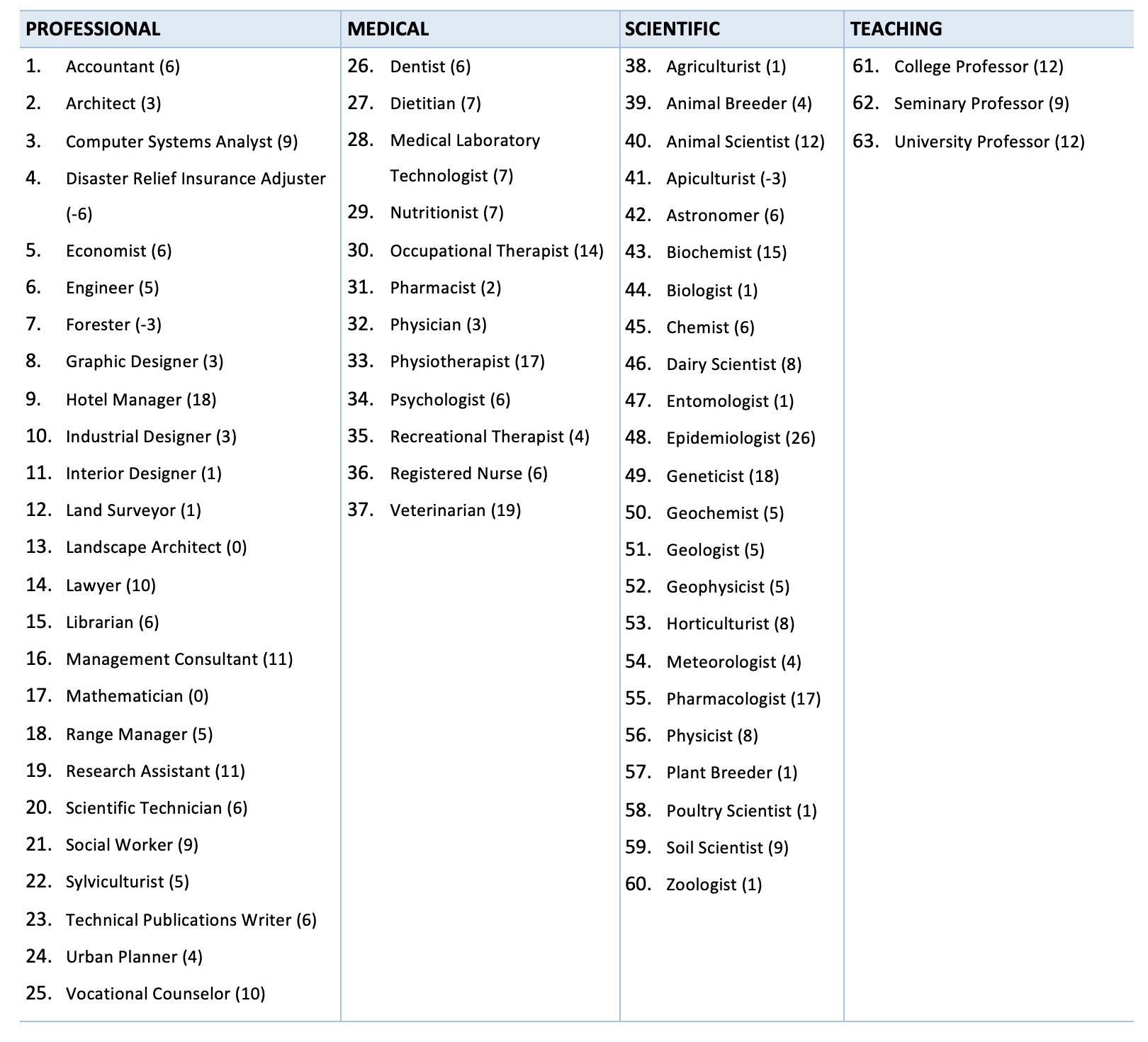
Source https://www.ecfr.gov/current/title-8/chapter-I/subchapter-B/part-214/section-214.6 and https://www.bls.gov/ooh/.
Limitations of the Current List
As Table 1 shows, the TN system is only for higher-skilled professions, in fields such as health care, engineering, research, teaching, and executive and administrative positions. Evidently, the list does not properly reflect the needs of the U.S. labor market. Significantly, this list of professions has not been revised or updated since 1994, when NAFTA was enacted. While the number of TN visas has grown in the last 13 years, there could have been greater growth — and more help in diminishing U.S. labor shortages — with broader flexibility on the kinds of jobs or professions it covers.
Many of the jobs that Mexicans fill in the U.S. labor market are not on the TN visa list — such as agriculture, food processing, landscaping, hospitality, and construction — so they have no incentive to apply for the TN visa and prefer to enter the U.S. using another type of visa or without a work permit. Reconsidering the TN visa and broadening its scope could clearly help both Mexican workers who are seeking employment in the U.S. and employers who need more workers in a range of industries.
U.S. Industries in Need of More Workers
The Bureau of Economic Analysis (BEA) estimates the U.S. GDP and its components. The four industries with the highest participation in the U.S. GDP are: 1) finance, insurance, real estate, rental, and leasing; 2) manufacturing; 3) professional and business services; and 4) educational services, health care, and social assistance.[20] Some of these industries have experienced labor shortages in recent years, worsened by the pandemic, which has resulted in lower production and hence lower economic growth. Although Canadians and Mexicans with TN status have access to some of the occupations in these industries, not enough have not been employed to meet the need. And there are of course many other industries that do not qualify for these visas.
Health Care. Immigrants make up around 17.4% of the health care labor force in the U.S.[21] Mexico and Canada are among their most common birthplaces.[22] However, more immigrants are needed as the U.S. will face a shortfall of up to 48,000 primary care physicians and 77,100 non-primary care physicians by 2034.[23] In addition, the shortage of registered nurses has worsened since the pandemic, with a decrease of more than 100,000.[24]
Manufacturing. In the manufacturing industry, immigrants represent about 12% of total workers.[25] This industry has also struggled to find workers, and during the pandemic, manufacturing lost around 1.4 million jobs. By the end of 2020, it was able to rehire 820,000 of those jobs, but 570,000 jobs remain unfilled.[26] The labor shortage in this industry by 2030 will be approximately 2.1 million, and the cost associated with these missing jobs could add up to $1 trillion in 2030 alone.[27] Mexican and Canadian engineers, for example, could be part of the solution.
These two industries are good examples of what is happening in the U.S. labor market. Firms want to hire workers, but they cannot find good candidates. This is also happening in other key industries such as transportation, accommodation, food, and retail. These labor shortages have a multiplier effect in other sectors, stagnating the U.S. economy in low economic growth.
The situation leads us to pose two questions:
- Why does the U.S. government not realize that more overseas workers are willing to work in the U.S. as nonimmigrants, for a specified period?
- Why do U.S. firms not use the TN visa more extensively? Even with the limitation that only 63 professions qualify, companies could take advantage of TN visas to fill more jobs.
We suggest that the answer to both questions lies in the current environment toward immigration. Companies in the U.S. may not want to use foreign workers extensively, as that could open them to attack by proponents of nativism.
Current Labor Shortages. A significant share of the shortages is in occupations that rely heavily on manual labor.[28] Since the TN visa requires a bachelor’s degree, it cannot be used for people to fill these jobs. Professions in industries with acute labor shortages that are on the TN list include social workers, all medical professions, and teachers. Health-related occupations have severe labor shortages because of aging and retiring baby boomers, particularly registered nurses.[29]
Currently, the industries with the highest labor shortages are:
- leisure and hospitality;
- professional and business services;
- financial services; and
- durable goods manufacturing.[30]
The highest job opening rates by industry since February 2021 are in transportation, warehousing, and utilities; professional and business services; health care and social assistance; and leisure and hospitality.[31]
Job Projections for the Decade 2021-2031. We analyzed the BLS occupational projections for 2021-2031 (holding other variables constant), and found that in the coming years the U.S. economy will need more workers, and labor shortages will continue. The U.S. economy will add 8.3 million jobs from 2021 to 2031.[32] The unemployment rate, on average, will remain constant at around 4.1% after 2026.[33] The health care and social assistance sector is projected to create the most jobs over that decade due to the aging U.S. population.[34] The projected growth of all health care occupations is 13% for this period, resulting in about 2 million new jobs during that time.[35] Leisure and hospitality will grow the fastest among all sectors during that decade, and the food and drink services industry will have the largest employment increase of any industry (about 1.3 million jobs).[36] The latter industry will need more workers, but again most of the occupations in these industries are included under the TN visa.
Growth Projection for Jobs on the TN List. For the period 2021 to 2031, the average job growth projection is about 6.7%.[37] The occupations with access to the TN status and with the highest outlook for job growth include epidemiologists (26%), veterinarians (19%), hotel managers (18%), geneticists (18%), physiotherapist/physical therapists (17%), and pharmacologists (17%). When looking at these job projections, however, there are several points to keep in mind:
- The numbers of TN visa holders are still low in comparison to the quantity of workers needed, so we should incentivize firms and potential workers to take advantage of this visa.
- Many occupations not on the TN visa list have a higher job growth outlook. For 17 occupations on the list, their projected growth is less than 3%, and three have a negative outlook. So, these 17 occupations should be replaced by other occupations that potentially have higher job growth.
- The TN visa list does not include a detailed description of the occupations, and USCIS guidance and consular officials’ interpretations have sometimes narrowed the potential scope of the list.[38] Two examples provide useful illustration:
(a) Economists generally specialize in either microeconomics or macroeconomics and also in specific areas, such as labor, international trade, development, econometrics, education, health, or finance — these sub-categories are not included in the TN list. A policy memorandum released by U.S. Citizenship and Immigration Services in 2017 established who can apply under the TN economist category and distinguished between the position of economist (on the TN list) versus the position of financial analyst (not on the TN list), even though an economist can work as a financial analyst.[39]
(b) Projected job growth for the category “mathematician” (on the TN list) is 0%, while the growth projection is very high for other, related categories that are not on the list. For example, job growth of 33% is expected for mathematicians in statistics, who analyze data using statistical methods.[40] If a worker applies for the TN visa as a mathematician in that field, he may get a visa for that job, but he may not; it will depend on whether the consular officer believes that the worker meets the requirement of working as a mathematician. To avoid this confusion, a detailed description should be included for each of the TN occupations or the fields in which each TN occupation can work. - The percentage projections don’t tell the whole story; we must look at the actual numbers as well. Some occupations on the list will generate more jobs and others fewer. For example, although epidemiologists have one of the highest employment projections at 26%, the employment growth will only be 2,200. Registered nurses have a projected job growth of 6% for that decade, but the number of actual jobs needed will be 195,400.
Mexican Immigrants in the U.S. Mexican immigrants have been coming to the U.S. in large numbers for many decades. Many do so legally, while many others come without authorization. In 2021, 10.7 million Mexican immigrants lived in the U.S., of which 5.3 million were undocumented.[41]
Interestingly however, the Mexican immigrant population decreased by 9% between 2010 and 2021.[42] From 2013 until the outbreak of the coronavirus pandemic, Mexico was no longer the country with the greatest number of immigrants in the U.S.; it was surpassed by India and China.[43] But, due to the pandemic and the deteriorating economic, social, and security conditions in Mexico since Andrés Manuel López Obrador became president, Mexico has once again become the largest home country of immigrants in the U.S. This trend will only accelerate if the Mexican government does not make substantial changes to its policies.
The number of Mexicans working in the U.S. was approximately 7.4 million in 2022.[44] The Mexican migrant population works mainly in the construction sector (20.9%), professional and administrative services (12.8%), manufacturing (12.6%), hospitality and leisure (12.2%), retail (11.3%), education and health (9.8%), transportation (5.7%), and agriculture (5.3%).[45] It therefore makes sense to link the TN visa to these sectors and take advantage of the fact that Mexicans are willing to work in the U.S.
TN Visa is a Nonimmigrant Visa
Finally, it is important to emphasize this: The TN visa is a nonimmigrant visa. Unlike many others, it does not lead to permanent residence or citizenship in the United States. Although many Mexican citizens do migrate to the United States on immigrant visas, many others work in the U.S. with nonimmigrant visas — e.g., H2-A or H2-B or TN — or without documents. The TN visa is likely to remain a nonimmigrant visa, but it would allow an orderly and legal way for workers and employers to find each other and enter into a mutually convenient employment arrangement, protected by treaty and regulated largely by market forces. Because the TN visa is indexed to U.S. economic performance, its use will naturally increase (job offers will be generated) with economic growth and decrease when the economy experiences a slowdown.
Conclusion
The importance of immigrant workers in the U.S. economy is clear. In recent years a decrease in immigration has affected the U.S. labor market and generated labor shortages. Changes in the U.S. visa system to allow more immigrant workers into the country could alleviate this problem but are not a realistic prospect in the current political environment. It is, however, possible to update and expand the scope of the TN visa list and make greater use of this nonimmigrant visa.
The TN visa has already alleviated, in some way, the U.S. labor shortage in some key sectors, such as health care and manufacturing, and the ideal scenario would be to now expand this list to other occupations, particularly in sectors with labor shortages that Mexican migrants work in. This could be done in two ways:
- Introduce a negative list, specifying what occupations and skills do not qualify for the TN visa, instead of having a narrow list of professions that do qualify.
- Remove from the list the 17 occupations with no job growth projected in the coming years and replace them with other occupations with high numbers of job openings and worker shortages.
Expansion of this visa will open the door to a win-win situation where the U.S. labor market will be able to hire the workers it needs and more Mexicans can come to the U.S. legally — reducing the incentive to come to the U.S. without documents. Even without changes in the TN list, the goal should be to encourage the use of this visa by U.S. firms to employ Mexican and Canadian workers.
The USMCA parties will be analyzing potential modifications to the agreement in 2026, so it is vital to include TN visa in the discussion: Updating the TN list will strengthen the regional labor market and make greater use of this visa category. It will benefit all three countries in North America for decades to come.
Endnotes
[1] Jose Ivan Rodriguez-Sanchez, “Immigrants in Strategic Sectors of the U.S. Economy and America’s Labor Shortage Crisis,” Rice University’s Baker Institute for Public Policy, June 14, 2022, https://www.bakerinstitute.org/research/immigrants-in-strategic-sectors-of-the-us-economy-and-americas-labor-shortage-crisis; United States Joint Economic Committee. JEC, “Immigrants Are Vital to the U.S. Economy,” U. S. Joint Economic Committee,” April 26, 2021, https://www.jec.senate.gov/public/index.cfm/democrats/2021/4/immigrants-are-vital-to-the-u-s-economy.
[2] Further examples from Rodriguez-Sanchez, “Immigrants in Strategic Sectors:”
- While only 9.2% of immigrants work in construction and extraction, they represent about 29.7% of all workers in these occupations.
- While just 4.2% of immigrants work in health care support occupations, they make up approximately 22% of all the occupations in this rapidly growing industry.
- Another key sector in which immigrants work is Information Technology (IT), where one out of every four or 25% of all workers are immigrants.
[3] “The nonimmigrant NAFTA Professional (TN) visa allows citizens of Canada and Mexico, as NAFTA professionals, to work in the United States in prearranged business activities for U.S. or foreign employers.” See https://travel.state.gov/content/travel/en/us-visas/employment/visas-canadian-mexican-nafta-professional-workers.html.
[4] The TN visa is covered by Chapter 16 of the USMCA. Given that the sunset clause of the USMCA mandates review and revision of chapter 16 by 2026, there is a clear opportunity to expand and improve on the scope of the TN visa.
[5] For a complete list of temporary work visas, see https://www.bakerinstitute.org/research/immigrants-in-strategic-sectors-of-the-us-economy-and-americas-labor-shortage-crisis.
[6] The U.S. federal government’s fiscal year runs from October 1 to September 30. Annual visa issuances provide an approximate idea of the number of visa holders entering the United States in a year, but they are not an exact measure.
[7] Michael D. Shear and Miriam Jordan, “Trump Suspends Visas Allowing Hundreds of Thousands of Foreigners to Work in the U.S.,” New York Times, June 22, 2020, https://www.nytimes.com/2020/06/22/us/politics/trump-h1b-work-visas.html.
[8] Based on a civilian noninstitutional population of 266 million.
U.S. Bureau of Labor Statistics, “The Employment Situation — April 2023,” U.S. Department of Labor, April 7, 2023, https://www.bls.gov/news.release/pdf/empsit.pdf.
[9] Pia Orrenius and Chloe Smith, “Without Immigration, U.S. Economy Will Struggle to Grow,” Federal Reserve Bank of Dallas, April 9, 2020, https://www.dallasfed.org/research/economics/2020/0409.
[10] Estimated figure extrapolated from a 2016 data found in FWD.us., “Immigration Facts: The Positive Economic Impact Of Immigration,” July 21, 2020, https://www.fwd.us/news/immigration-facts-the-positive-economic-impact-of-immigration/.
[11] Jose Ivan Rodriguez-Sanchez, “Immigrants in Strategic Sectors of the U.S. Economy and America’s Labor Shortage Crisis,” Rice University’s Baker Institute for Public Policy, June 14, 2022, https://www.bakerinstitute.org/research/immigrants-in-strategic-sectors-of-the-us-economy-and-americas-labor-shortage-crisis
[12] International Trade Administration, “North American Free Trade Agreement (NAFTA),” July 2020, https://www.trade.gov/north-american-free-trade-agreement-nafta.
[13] NASFA: Association of International Educators, “NAFSA Adviser’s Manual 360 – 8 CFR 214.6,” October 16, 2008, https://www.nafsa.org/_/file/_/amresource/8cfr2146.htm.
[14] USCIS, “TN NAFTA Professionals,” February 24, 2021, https://www.uscis.gov/working-in-the-united-states/temporary-workers/tn-nafta-professionals.
[15] Even if the TN status was given for three years, once a year had passed since issue of the visa, a Mexican visa holder who decided to travel outside the U.S. had to apply each year for a visa stamp. Those who chose not to travel outside of the U.S. could stay in the country for up to three years.
[16] Lindsey Steinberg, “Department of State Provides Option of Four-Year TN Visa for Mexican Citizens,” Mintz, January 5, 2023, https://www.mintz.com/insights-center/viewpoints/2806/2023-01-04-department-state-provides-option-four-year-tn-visa.
[17] The visas considered for this estimate were: E-1, E-2, E-3, H1-B, H2-A, H2-B, I, L-1, L-2, O-1, O-2, P-1, P-2, P-3, R-1 and TN.
[18] Department of Homeland Security, “Nonimmigrant Admissions,” September 26, 2022, https://www.dhs.gov/immigration-statistics/nonimmigrant. (Please see the Nonimmigrant Admissions Data Tables and Supplementary Data Tables).
[19] Department of Homeland Security, “Nonimmigrant Admissions,” September 26, 2022, https://www.dhs.gov/immigration-statistics/nonimmigrant. (Please see the Nonimmigrant Admissions Data Tables and Supplementary Data Tables).
[20] U.S. Bureau of Economic Analysis (BEA), “GDP by Industry,” December 22, 2022, https://www.bea.gov/itable/gdp-by-industry.
[21] Jeanne Batalova, “Immigrant Health-Care Workers in the United States,” Migration Policy Institute, April 7, 2023, https://www.migrationpolicy.org/article/immigrant-health-care-workers-united-states.
[22] Davis Patterson, Cyndy Snyder, and Bianca Frogner, “Immigrants in Healthcare Occupations,” Center for Health Workforce Studies, University of Washington, January 2017, https://depts.washington.edu/fammed/chws/wp-content/uploads/sites/5/2017/01/Immigrants-in-Healthcare-Occupations_FR_Jan_2017-Patterson.pdf.
[23] Association of American Medical Colleges, “The Complexities of Physician Supply and Demand: Projections From 2019 to 2034,” June 2021, https://www.aamc.org/media/54681/download.
[24] American Association of Colleges of Nursing, “Fact Sheet: Nursing Shortage,” October 2022, https://www.aacnnursing.org/news-information/fact-sheets/nursing-shortage.
[25] Dan Kosten, “Immigrants as Economic Contributors: They Are the New American Workforce,” National Immigration Forum, June 5, 2018, https://immigrationforum.org/article/immigrants-as-economic-contributors-they-are-the-new-american-workforce/.
[26] Paul Wellener,, Victor Reyes, Heather Ashton, and Chad Moutray, “Creating Pathways for Tomorrow’s Workforce Today,” Deloitte Insights, May 4, 2021, https://www2.deloitte.com/us/en/insights/industry/manufacturing/manufacturing-industry-diversity.html.
[27] NAM News Room, “2.1 Million Manufacturing Jobs Could Go Unfilled by 2030,” National Association of Manufacturers, May 4, 2021, https://www.nam.org/2-1-million-manufacturing-jobs-could-go-unfilled-by-2030-13743/?stream=workforce.
[28] Gad Levanon and Frank Steemers, “Future Occupational Labor Shortages Risk Index,” The Conference Board, March 25, 2022, https://www.conference-board.org/topics/labor-shortages/Labor-Shortages-Risk-Index.
[29] American Association of Colleges of Nursing, “Fact Sheet: Nursing Shortage,” October 2022, https://www.aacnnursing.org/news-information/fact-sheets/nursing-shortage.
[30] Stephanie Ferguson, “Understanding America’s Labor Shortage: The Most Impacted Industries,” U.S. Chamber of Commerce, May 16, 2023, https://www.uschamber.com/workforce/understanding-americas-labor-shortage-the-most-impacted-industries.
[31] Bureau of Labor Statistics data set, “Job Openings Rates by Industry, Seasonally Adjusted,” U.S. Department of Labor, n.d., https://www.bls.gov/charts/job-openings-and-labor-turnover/opening-industry.htm.
[32] “Employment Projections: 2021-2031 Summary – 2021 A01 Results,” n.d., https://www.bls.gov/news.release/ecopro.nr0.htm.
[33] Congressional Budget Office, “An Overview of the Economic Outlook: 2021 to 2031,” February 1, 2021, https://www.cbo.gov/publication/56965.
[34] Bureau of Labor Statistics, “Employment Projections: 2021-2031 Summary,” U.S. Department of Labor, September 8, 2022, https://www.bls.gov/news.release/ecopro.nr0.htm.
[35] Bureau of Labor Statistics, “Healthcare Occupations,” U.S. Department of Labor, September 8, 2022, https://www.bls.gov/ooh/healthcare/home.htm.
[36] Bureau of Labor Statistics, “Employment Projections: 2021-2031 Summary,” U.S. Department of Labor, September 8, 2022, https://www.bls.gov/news.release/ecopro.nr0.htm.
[37] Bureau of Labor Statistics data set, “Occupational Handbook,” September 8, 2022, https://www.bls.gov/ooh/.
[38] Each consular officer decides on the application before them whether a job fits within a TN status category, with guidance from USCIS policy memoranda. Because the decision comes down to the individual consular officer, inconsistent adjudications can and do happen.
[39] Policy Memorandum PM-602-0153, TN Nonimmigrant Economists Are Defined by Qualifying Business Activity, U.S. Citizenship and Immigration Services, , November 20, 2017, https://www.uscis.gov/sites/default/files/document/memos/2017-1120-PM-602-0153_-TN-Economists.pdf.
[40] Bureau of Labor Statistics, “Mathematicians and Statisticians,” U.S. Department of Labor, February 6, 2023, https://www.bls.gov/ooh/math/mathematicians-and-statisticians.htm#tab-6.
[41] Data set, Migration Policy Institute, “Profile of the Unauthorized Population: United States,” 2019, https://www.migrationpolicy.org/data/unauthorized-immigrant-population/state/US; Raquel Rosenbloom and Jeanne Batalova, “Mexican Immigrants in the United States,” Migration Policy, October 13, 2022, https://www.migrationpolicy.org/article/mexican-immigrants-united-states.
[42] Rosenbloom and Batalova, “Mexican Immigrants in the United States.”
[43] Batalova and Rosenbloom, “Mexican Immigrants in the United States.”
[44] Jesús González and Denisse Ostolaza, “Determinantes del porcentaje de su ingreso que envían como remesas los mexicanos inmigrantes en Estados Unidos a sus familiares en México (Determinants of the percentage of their income that Mexican immigrants in the United States send as remittances to their relatives in Mexico),” FR CEMLA, February 2023, https://www.findevgateway.org/es/publicacion/2023/02/determinantes-del-porcentaje-de-su-ingreso-que-envian-como-remesas-los.
[45] Juan José Li Ng, “Mexico | Does 1 in 5 Pesos of Remittances Come from Mexicans in the Construction Sector?” BBVA Research, January 3, 2022, https://www.bbvaresearch.com/en/publicaciones/mexico-does-1-in-5-pesos-of-remittances-come-from-mexicans-in-the-construction-sector/.
This research is generously supported by a grant from the Charles Koch Foundation.
This material may be quoted or reproduced without prior permission, provided appropriate credit is given to the author and Rice University’s Baker Institute for Public Policy. The views expressed herein are those of the individual author(s), and do not necessarily represent the views of Rice University’s Baker Institute for Public Policy.


